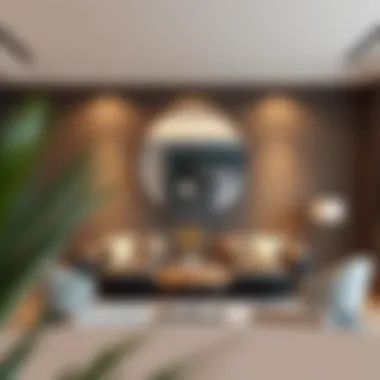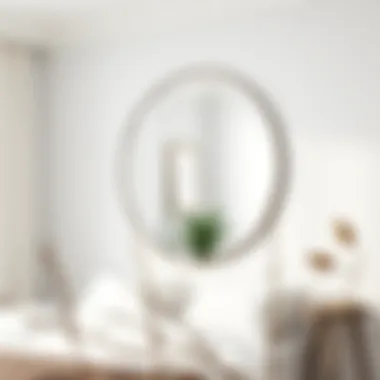Exploring Aesthetic Mirrors for Home Design


Intro
Aesthetic mirrors have long held a special place in the world of home decor. They do more than just reflect; they can transform a space, shifting the mood from dull to dynamic. This guide will plunge into the multifaceted universe of aesthetic mirrors, addressing their importance in today's design landscape. From the materials used to the various styles available, we’ll navigate through the nuances that make these reflective surfaces more than mere glass.
Whether you're a homeowner looking to spice up your space or an interior designer searching for fresh ideas, this comprehensive overview aims to provide valuable insights. By the end, you’ll be well-informed about how mirrors can enhance both functionality and beauty in your living environment.
Understanding Aesthetic Mirrors
Aesthetic mirrors serve not just as functional objects—they're instrumental in shaping the atmosphere and visual layout of a space. For homeowners, interior designers, and decorating aficionados, understanding these mirrors involves grasping their multifaceted roles in enhancing decor and improving the spatial dynamics within various environments.
Different styles and designs of mirrors can evoke distinct emotions or create unique focal points. They reflect light, manipulate the perception of space, and contribute to a room's overall aesthetic narrative. This section aims to elucidate the importance of aesthetic mirrors and highlight essential considerations that should guide one’s choices.
Definition and Purpose
In the simplest terms, an aesthetic mirror is any mirror that emphasizes visual appeal along with functionality. While a basic mirror reflects our image, an aesthetic mirror transcends this by enhancing the decor of the space it inhabits.
These mirrors come in various designs and sizes—ranging from opulent, ornate pieces to sleek, minimalistic designs. Their purpose extends beyond mere reflection. For example, a beautifully framed mirror can underscore a specific design theme, draw attention to an art piece, or even make a cozy space look more expansive.
Understanding the purpose also involves recognizing how mirrors can be used to manipulate light. This can be particularly beneficial in dimly lit areas where natural light is limited. A thoughtfully placed mirror catches and reflects available light, helping to brighten a room and create a more open ambiance.
Historical Context
To appreciate the aesthetic mirror fully, one must consider its historical evolution. Mirrors date back to ancient civilizations, where they were made from polished metals like bronze and silver. These early mirrors, while functional, primarily held an ornamental status, often adorned with intricate designs and used in ceremonial contexts.
Fast forward to the Renaissance period, when glass mirrors came onto the scene, allowing for a more refined reflection. They quickly became symbols of wealth and sophistication, finding their place in the grandest of palaces and the homes of the elite. The Venetian glass mirrors, in particular, are heralded for their craftsmanship and artistry.
This rich history has paved the path for today's aesthetic mirrors, where their roles have diversified. Nowadays, mirrors are seen in various forms and styles throughout diverse cultures, reflecting not only personal identity but also individual taste and the era’s design language. Throughout the years, the fundamental purpose of mirrors has remained, yet their aesthetic contributions are more pronounced in contemporary interior designs.
If we consider the journey of mirrors through time, we see a reflection not just of our images, but of our evolving tastes and cultural narratives as well.
"The mirror is a reflection of you, but it’s also a reflection of the space you inhabit."
Understanding both the purpose and the historical context of aesthetic mirrors equips one with the insight needed to select those that enhance and resonate with their own living spaces.
Types of Aesthetic Mirrors
When it comes to aesthetics in home decor, mirrors are often the unsung heroes. Not only do they have a practical role in our daily lives, but they also elevate the overall ambiance of a space. The various types of aesthetic mirrors can drastically alter the characteristics of a room. From large, stand-alone fixtures to intricately bordered varieties, each type serves its unique purpose while enhancing the beauty of an area. Understanding these differences allows homeowners and decorators alike to make informed decisions on how best to integrate these reflective surfaces into their spaces.
Framed Mirrors
Framed mirrors are perhaps the most popular choice among homeowners. They can range from classic wooden borders to sleek metal frames, catering to virtually every interior design style imaginable. Why are they so important? A well-chosen frame not only complements the decor but also acts as a statement piece. A large baroque frame can become a focal point in a modern living room, drawing the eye with its ornate detailing.
- Benefits: The main advantage of framed mirrors is their flexibility in design. They can add texture and personality to a room. Additionally, a frame can provide necessary contrast against flat walls or other decor elements.
- Considerations: It's essential to consider the scale and color of the frame. A mismatch can lead to an aesthetic clash, while the right frame can bring harmony.
Floor Mirrors
Floor mirrors pack a powerful punch when it comes to style and utility. These tall reflections serve not only as a functional piece for checking outfits but also as striking decor accents in various settings. Imagine a spacious hallway or bedroom featuring a full-length mirror leaning against a wall; it’s a practical setup that promotes a sense of openness.
- Benefits: Besides their utility, floor mirrors can help to create the illusion of a larger space. They reflect light and the surrounding decor, effectively multiplying the visual dimension of a room.
- Considerations: Ensure that the placement doesn’t obstruct traffic flow. Also, consider anchoring the mirror in place to avoid accidents, especially in homes with children or pets.
Wall Mirrors
Wall mirrors come in various shapes and sizes, often customizable to fit specific wall spaces perfectly. They can be playful or elegant, minimalistic or flashy, which makes them adaptable to any decor scheme. Their versatility allows them to fit in corridors, living rooms, or even dining spaces.
- Benefits: Wall mirrors can be arranged in such a way to create an artistic gallery, adding depth and dimension. They hold the capability of enhancing natural light, reflecting it throughout the room.
- Considerations: Placement height is crucial. A mirror too high or low can lose its intended purpose. Ideally, a wall mirror should be at eye level for optimal use.
Vanity Mirrors
Vanity mirrors are tailored specifically for areas dedicated to daily grooming and primping. Characterized by their smaller sizes, they often come with features like built-in lighting and storage options, which can amplify their functionality.
- Benefits: They are the unsung heroes of personal grooming routines. A well-designed vanity mirror can transform the mundane task of getting ready into an enjoyable experience.
- Considerations: When selecting a vanity mirror, consider the amount of available space on the vanity itself. The mirror should enhance functionality without overwhelming the area.
"Mirrors reflect not just our appearance but also our personal style. The right choice can elevate the whole environment!"
In summary, understanding the different types of aesthetic mirrors can prepare homeowners and interior designers to make choices that will not only beautify but also serve functional roles in their spaces. Each type holds its own charm and utility, making a significant impact on the overall aesthetics of any room.
Materials Used in Aesthetic Mirrors
When diving into the world of aesthetic mirrors, the materials used in their construction are crucial. Not only do they define the appearance of the mirror, but they also affect its longevity, functionality, and overall ambiance in a space. Selecting the right materials can bring to life the desired atmosphere, whether you’re aiming for sleek modernity, rustic charm, or gleaming opulence. Let’s take a deep dive into the types of materials typically involved in aesthetic mirror production, their characteristics, and the considerations that come with each.
Glass Types
The glass used in mirrors plays a pivotal role in determining their quality and aesthetic appeal. Clear glass is the most common choice and provides a classic, unobtrusive reflection. However, frosted glass offers a softening effect and blurs details, contributing to a more abstract, artistic look. On the other hand, colored glass can be used for dramatic flair or to match color schemes, while antique glass, often found in vintage mirrors, brings a sense of history and unique character.
Worthy of noting is the importance of thickness. Thicker glass is more durable and less prone to warping, ensuring a truer reflection over time. An appropriate choice of glass type can elevate the mirror beyond mere functionality into a captivating decorative piece.
Wooden Frames
Wooden frames have an age-old connection to mirrors, frequently adding warmth and texture to a room. From classic oak to elegant walnut, the type of wood impacts both the style and feel of the mirror. A rustic pine frame might evoke a cozy cabin vibe, while mahogany denotes sophistication and luxury.
In addition to aesthetic considerations, the craftsmanship of the frame is key. Hand-carved details can showcase artisanal skill and artistry, turning a simple mirror into a statement piece. It’s worth mentioning that wood can be susceptible to moisture damage. Thus, proper positioning away from high-humidity areas might be necessary to protect those frames from warping or cracking over time.
Metal Frames
Metal frames introduce a sleek, modern vibe to aesthetic mirrors. Materials like stainless steel and brass can complement a myriad of interior aesthetics, from industrial chic to luxurious modernism. Not to mention, metal frames come in various finishes—polished, brushed, or matte—that can drastically change the appearance.
The durability of metal also makes it a favorable option for mirrors in high-traffic areas. They can withstand the test of time, maintaining both their structural integrity and visual appeal. The heavy weight of a metal frame often requires sturdy hardware for sufficient support during installation, so that’s something to keep in mind when considering placement.
Plastic and Acrylic Options


While often overlooked, plastic and acrylic mirrors hold a special place in the aesthetic realm. Lightweight, affordable, and resistant to shattering, these materials offer flexibility in design. Available in a variety of colors and styles, acrylic mirrors can mimic glass but with less risk of injury or breakage—especially in homes with kids.
Moreover, the ease of manufacturing allows for unique shapes and designs that can be tailor-made for specific decor styles. However, it’s wise to note that lower quality options may scratch easily or lose clarity over time. Careful selection can ensure that the desired aesthetic isn't compromised.
Functional Benefits of Aesthetic Mirrors
Aesthetic mirrors go beyond mere decoration; they play pivotal roles in enhancing living spaces. Understanding their functional benefits is crucial for homeowners, interior designers, decorators, and anyone looking to elevate their environments. They are not just reflective surfaces but versatile items that can redefine the perception of space, optimizing its usability and appeal.
Enhancing Space Perception
One of the standout advantages of aesthetic mirrors is their ability to create the illusion of larger spaces. In small rooms, a well-placed mirror can trick the eye, making the area feel considerably more open and airy. By reflecting the room's contents and light, mirrors can double the visual space, engendering a sense of freedom in what might otherwise seem cramped.
For example, placing a mirror opposite a window can bounce light around the room, contributing to an inviting atmosphere. As a rule of thumb, if your goal is to give a cozy nook an expansive feel, consider a sizeable, well-framed mirror hung at eye level. This placement not only increases the spatial perception but can also enhance the existing decor, drawing the eye towards your design choices rather than the limitations of a small area.
Improving Lighting
Another significant functional benefit of mirrors is their contribution to lighting—a factor that profoundly impacts mood and functionality in any space. Mirrors reflect both natural and artificial light, which can lead to brighter, more vibrant interiors. By strategically placing mirrors in areas where natural light enters, such as near windows or in dimly lit hallways, you can amplify the illumination in your environment remarkably.
Consider the scenario of a living room with minimal light—a centered mirror above the sofa acts not only as a decorative element but also as a light enhancer. The sunlight that spills in during the day is mirrored across the room, creating a warm and welcoming ambiance. In the evenings, well-lit rooms feel safer and cozier, reducing the starkness often associated with less illumination.
Additionally, mirrors can serve as a focal point in rooms that rely heavily on artificial lighting. By reflecting lamps or overhead fixtures, they can help distribute light more evenly, resulting in a balanced glow throughout the space.
Reflecting Decor
Aesthetic mirrors also have a unique role in reflecting and amplifying decorative themes throughout your home. They don’t merely serve to display a reflection; they act like a canvas for the decor style you wish to showcase. For instance, a vintage ornate mirror can tie together a classic decor theme while a sleek, modern mirror enhances contemporary designs.
Mirrors can also be used to create layers in a room's aesthetic by reflecting colors and textures from furniture and decor elements. This reflective quality fosters cohesion within the space.
"Mirrors are the only objects that can show your whole face without any distortion, and they also show the fantastic decor choices you've made."
In certain setups, mirrors can also create a dynamic interplay of shapes and forms, leading to a visually rich experience. You might choose a round mirror in a square room to soften hard lines or use a series of smaller mirrors to form a collage effect, bringing more personality to the walls.
Whether it's enhancing space perception, improving lighting conditions, or reflecting carefully curated decor elements, aesthetic mirrors are essential tools in achieving heightened functionality and design synergy. Their multifaceted benefits make them integral to effective and appealing interior design.
Design Trends Influencing Aesthetic Mirrors
The realm of aesthetic mirrors is not just about functionality; it's also a canvas reflecting evolving design trends that resonate with people's lifestyles and preferences. As homeowners seek to express their identities through their living spaces, mirrors have transcended traditional roles. They now serve dual purposes—offering utility while also acting as stunning artworks. The importance of understanding these trends lies in their ability to enhance the ambiance of a room, making spaces feel larger, lighter, and more engaging.
Minimalism and Simplicity
In an age where clutter can feel overwhelming, minimalism springs forth as a sanctuary. Aesthetic mirrors designed with clean lines and understated elegance embody this movement. Think simple frameless designs that allow the glass to blend seamlessly into any wall—often making a statement without shouting. These mirrors act as visual breathing spaces, drawing attention without overpowering other decor elements.
- Key characteristics:
- Uncluttered design: Emphasizing space over embellishment.
- Natural materials: Often utilizing wood or metal in their purest forms.
- Neutral palettes: Soft whites, light woods, and cool metals embracing the essence of tranquility.
Overall, opting for minimalist mirrors can transform cramped rooms into open expanses, allowing homeowners to create an oasis of calm in their homes.
Vintage and Retro Styles
Nostalgia has a powerful grip on design. Vintage and retro mirrors celebrate history in decor. These mirrors, often crafted with ornate frames or whimsical shapes, transport us to earlier eras where craftsmanship was paramount. The resurgence of these styles invites a sense of warmth and personal connection to past aesthetics.
- Key aspects include:
- Intricate frames: Whether aflame with gold leaf or featuring distressed paint, these frames serve as conversation starters.
- Diverse shapes: Round, oval, or even irregular forms that challenge modern perceptions of 'perfect.'
- Rich textures: Drawing from the tactile quality of bygone days, including patinas and aged finishes.
Incorporating these mirrors into spaces can evoke cherished memories or remind one of family heirlooms, making a house feel like home.
Eclectic and Bohemian Influences
Diving deeper into the world of interior design, we encounter the eclectic and bohemian styles that celebrate individuality and vibrant expression. Aesthetic mirrors in this category are often a medley of colors, patterns, and designs. They do not merely reflect; they engage, energize, and inspire.
- Key elements to consider:
- Variety of designs: An assortment of geometric patterns and intricate carvings that tell a story.
- Bold colors: From deep jewel tones to muted pastels, these mirrors add an unexpected pop to any space.
- Artful configuration: Mirrors can be grouped artistically to create a gallery wall, combining various shapes and styles for a boho chic effect.
This approach allows homeowners to infuse personal stories and experiences into their decor, creating a truly unique environment that reflects their journey.
"The mirror not only reflects light but also memories and emotions, becoming a part of our everyday narrative."
Embracing contemporary trends in aesthetic mirrors not only adds style to a home but also embodies a lifestyle choice that resonates with individual values and aesthetics.
Choosing the Right Aesthetic Mirror
Selecting the perfect aesthetic mirror for your space isn't just a matter of finding a pretty piece to hang. It's about harmonizing the mirror with your home's overall vibe, functionality, and your personal taste. A mirror is more than a reflective surface; it serves as a focal point, a tool for enhancing light, and a means to create a sense of spaciousness. The importance of making an informed choice cannot be overstated, as this decision influences the mood and functionality of the entire room.
Assessing Aesthetic and Functional Needs
Before you even think about styles and colors, it’s crucial to consider what you really need from a mirror. Ask yourself some questions to clarify your aesthetic and functional needs:
- What purpose will the mirror serve? Are you aiming for a purely decorative piece, or do you need it as a functional element like a vanity mirror?
- What kind of ambiance are you trying to create? Consider how the mirror fits into the current decor style and the mood you want to evoke.
When you're assessing your needs, think about the placement. For example, a mirror in a hallway should be both functional for quick checks before leaving and appealing, as it’s often the first and last impression of a home. Taking these aspects into account can guide your decision-making process towards a mirror that meets aesthetic desires without sacrificing practical use.
Size and Scale Considerations
The size of your mirror heavily impacts the overall appearance of a room. A large mirror may dominate a small space, whereas a tiny mirror can get lost in an expansive wall. Here’s some guidance for choosing the right size:
- Measure the wall space. Use a measuring tape to find the width and height where you plan to install the mirror. This gives you a baseline for the size you should be considering.
- Visual balance. For a harmonious look, consider how the mirror interacts with nearby furniture. For instance, if you're placing a mirror above a console table, aim for about two-thirds the width of the table.
- Functionality. If the mirror is for an area where you’ll perform tasks, say in a bathroom, ensure it’s sized appropriately to give a good view.
In summary, ensuring the mirror matches not just the aesthetic but also the practical demands of the space is essential in making the right choice.


Frame Style Compatibility
The style of the mirror's frame can set the tone for the entire space. When deciding on frame style compatibility, consider the following:
- Existing Decor Styles: Look around your room and pick a frame that complements existing elements. For instance, a sleek modern frame would contrast poorly against a traditional decor, making the space feel disjointed.
- Color Harmony: Matching the color of the frame to other elements in the room helps create a cohesive flow. You don’t have to match everything exactly; rather, aim for colors that are complementary.
- Material Coordination: If you have notable wooden elements in your space, a wooden frame may mesh well. If your interiors lean towards metal fixtures, perhaps a metal-framed mirror would resonate better.
Choosing an aesthetic mirror is not just about the glass and frame; it's about selecting a piece that weaves seamlessly into your home’s narrative, enhancing both form and function.
"A mirror is not just a tool for reflection. It’s a portal to enhance your space and convey your style."
In making the right choice, consider your responses to the questions posed, and shop with these specific needs in mind. With a little thought and consideration, your aesthetic mirror will not only fulfill its functional role but also elevate the visual charm of your environment.
Placement Strategies for Aesthetic Mirrors
Placement of aesthetic mirrors is a pivotal aspect of interior design. It significantly influences not only the visual appeal of a space but also its energy flow and functionality. Strategic positioning of mirrors can create an illusion of spaciousness, bounce light around, and enhance the overall ambiance of a room. When considering where to hang or place a mirror, it's crucial to account for factors like room size, lighting sources, existing furnishings, and the intended mood of the space.
Here are some insights into how to best place mirrors in key areas of your home:
Living Room Considerations
The living room is often considered the heart of the home, a gathering place for family and friends. For this reason, mirrors should be selected and placed with care.
- Focal Points: Mirrors can serve as compelling focal points when hung above fireplaces or sofas. Choosing a statement mirror with an intricate frame can create interest and draw the eye.
- Size and Scale: A large mirror can make a smaller living room feel more expansive, while smaller mirrors can be grouped to form a gallery wall effect.
- Light Reflection: Aim to position mirrors opposite windows or light sources. This strategy helps reflect natural light, enhancing brightness in the room, which is particularly inviting.
- Avoid Clutter: Be wary of overloading a wall with too many decorations, including mirrors. A single, well-placed mirror can add depth without creating a chaotic look.
Entryway Enhancements
The entryway is like the welcome mat of your home. It sets the tone for guests as they step inside. Placement of mirrors here can have several benefits:
- Space Perception: A strategically placed mirror can make a narrow entryway feel wider. It tricks the eye into perceiving openness, giving a light and airy feel.
- Quick Check: A full-length mirror in the entryway allows for a quick glance before heading out, ensuring you're looking your best as you face the day.
- Decorative Touch: Whether a sleek frameless design or an ornate antique piece, a mirror can enhance the decor, providing a reflection of your personal style right at the door.
Bathroom Applications
Bathrooms often present unique challenges when it comes to mirror placement. Moisture, lighting, and functionality are factors that must be taken into account:
- Above the Sink: The most common location for a mirror in the bathroom is above the sink. Consider a wide mirror that provides ample reflection for multiple users at once.
- Think Functionality: Opt for mirrors with built-in lighting or magnifying features for better usability during grooming activities such as shaving or applying makeup.
- Style Cohesion: Ensure that the mirror complements the overall bathroom decor—whether it's a sleek modern look or a vintage charm, the mirror should contribute to the coherence of the design.
Mirrors are not just reflections; they are powerful tools in the design toolbox. They can breathe life into a space, providing not only functionality but also aesthetic enhancement. By carefully considering the placement of aesthetic mirrors, homeowners and design enthusiasts can elevate their interiors with a simple yet effective addition.
Aesthetic Mirrors in Different Decor Styles
Aesthetic mirrors serve not just a functional role in spaces, but also a profound artistic and design one. They can reflect personal style, enhance aesthetic appeal, and act as anchors in varied decor settings. When considering an aesthetic mirror for your home, it's pivotal to understand how these pieces can seamlessly integrate into distinct decor styles. Choices made in the selection of mirrors can influence the overall vibe of a space as well as reflect the personality of the homeowner. Different styles—modern, traditional, and contemporary—bring out unique traits that should be carefully contemplated when decorating.
Modern Decor
In modern decor, simplicity reigns supreme. Aesthetic mirrors in this style often embrace clean lines and minimalistic forms, providing a sense of tranquility and order. Mirrors with geometric shapes, frameless designs, or subtle metallic touches fit well within this aesthetic.
- Clarity and Openness: The clean surfaces and uncluttered nature of modern decor are complemented by mirrors that reflect light and create an illusion of a larger space. A strategically placed large mirror can double the light in a room, giving it an airy feel—absolutely ideal for smaller spaces.
- Integrated Functionality: Mirrors in modern settings often serve dual purposes. For instance, a sleek, wall-mounted mirror can act as a functional piece by incorporating shelving or hooks, maintaining that modern, utilitarian vibe.
“A mirror in a modern setting isn't just for checking your appearance; it's a statement of design, a bold reflection of the lifestyle that values function and simplicity.”
Traditional Decor
When it comes to traditional decor, aesthetic mirrors often evoke a sense of history and timeless elegance. This style tends to embrace ornate detailing, classic frames, and intrinsic craftsmanship.
- Timeless Frames: Mirrors with intricate wood carvings or gilded edges are staples in traditional settings. They may feature baroque or Victorian influences, emphasizing importance in detail. The right traditional mirror can encapsulate the essence of a room's decor, enhancing its rich, layered textures.
- Character and Warmth: A reflective surface in a cozy traditional living room can make it more inviting. It reflects not only the room's decor but also the warmth of a family’s gatherings, preserving memories in its charm.
Contemporary and Industrial Styles
The contemporary and industrial styles bring a different flavor to mirrors with their raw and edgy characteristics. Here, aesthetic mirrors play up a mix of old-world charm and modern utility. This decor style often comfortable blends function with art.
- Raw Materials: Mirrors can feature raw wood or metals, adding a rugged texture that complements exposed beams and brick walls common in industrial designs.
- Unique Shapes: Unconventional shapes or asymmetrical designs stand as focal points, providing dynamic visual elements while remaining functional. In spaces that are often characterized by clean lines, a uniquely shaped mirror can become a conversation starter.
Maintaining Aesthetic Mirrors
Aesthetic mirrors are not just the windows to your reflection; they play a significant role in enriching the overall decor of a space. However, as with any decorative element, proper maintenance is crucial to ensure their longevity and functionality. Maintaining your aesthetic mirrors involves understanding cleaning methods, being mindful of the environment surrounding them, and taking steps to prevent damages. This section elucidates the fundamental aspects of caring for these reflective surfaces and underscores their importance in sustaining the visual appeal of your interiors.
Cleaning and Care Recommendations
Clean mirrors aren’t just a sight for sore eyes—they also impact your space's ambiance. Dust and smudges can mar the elegance of even the most magnificent mirror, detracting from its aesthetic appeal. Here are some essential cleaning and care tips to keep your mirrors sparkling:
- Use the Right Products: Opt for a gentle glass cleaner or DIY solutions like vinegar and water mixed in a spray bottle. These are effective without damaging the reflective surface. Avoid harsh chemicals that can compromise the silver backing.
- Gentle Wipes: Use a microfiber cloth rather than paper towels, which can leave lint behind. A smooth, soft cloth ensures no scratches while wiping away buildup.
- Wipe in a Pattern: For streak-free results, consider wiping in a circular motion or using the squeegee technique. This approach minimizes streaks and ensures an even clean.
- Frequency Matters: Depending on your household, you may need to clean them weekly or bi-weekly. High traffic areas often require more frequent attention.
"Regular cleaning not only enhances the aesthetic appeal but prolongs the lifespan of the mirror itself."
Avoiding Damage from Moisture
Moisture is a formidable foe for aesthetic mirrors, especially in environments like bathrooms or kitchens where humidity levels can rise unexpectedly. Prolonged exposure to moisture can lead to unsightly issues, such as cloudiness or even mold growth.
Here are some strategies to protect your mirrors from moisture damage:
- Proper Placement: Where you place your mirrors is just as important as their style. Avoid hanging mirrors directly above sinks or bathtubs, where water splashes can occur.
- Ventilation: Ensure that the areas housing your mirrors are well-ventilated. Installing an exhaust fan in the bathroom can help mitigate humidity levels after showers.
- Sealant Application: For mirrors framed with wood, consider applying a waterproof sealant. This barrier helps prevent water from seeping into the frame and causing warping.
- Immediate Wipe Downs: After a shower or cooking, take a moment to quickly wipe down any condensation that may have accumulated on your mirrors.
Monitoring the condition of your mirrors and understanding how to effectively maintain them can lead to substantial benefits. Not only does good care keep them looking their best, but it also preserves the integrity of the materials used. By following these simple guidelines, you can ensure your mirrors remain a stunning focal point in your decor for years to come.
Sourcing Aesthetic Mirrors
Sourcing aesthetic mirrors involves more than just finding a reflective surface to hang on a wall. It encompasses understanding your needs, preferences, and the overall design of your space. Knowing where to look for these items can significantly influence not just your decor but the atmosphere of your home. As homeowners, interior designers, or decorators, sourcing mirrors is an art in itself—finding the right mirror means knowing how it will play off the light, space, and surrounding decor.
Retail Options


When delving into retail options for aesthetic mirrors, it is crucial to evaluate various aspects. Local furniture stores often carry a diverse range of mirrors, from vintage styles to contemporary designs. Visiting these stores allows one to see the mirrors up close, assess their quality, and sometimes even negotiate prices.
Moreover, big-box retailers like IKEA or Target offer affordable choices that align well with stylish and minimalist designs. Always consider the warranty or return policy when purchasing expensive mirrors; this ensures that you can return or exchange in case the fit isn’t right.
To find a good retail option, look for:
- Customer Reviews: Checking online reviews can give insight into the retailer’s reputation.
- Seasonal Sales: Many stores have end-of-season clearance sales that apply to mirrors.
- Local Markets: Sometimes local craft fairs or antique shops can yield unique finds that aren’t available in larger stores.
Online Marketplaces
In today’s digital age, online marketplaces have revolutionized how one sources aesthetic mirrors. Websites like Amazon and Wayfair provide extensive selections with the added convenience of home delivery. However, it’s essential to watch out for discrepancies between images and actual products when shopping online.
Key tips for this approach:
- Filter Options: Make sure to use filters to narrow down choices by size, style, or material.
- Detailed Descriptions: Examine product details carefully and check for measurements.
- Return Policies: Online purchases often come with specific return conditions—know these before confirming a buy.
Aside from general marketplaces, platforms like Etsy offer handmade and custom options that can cater to more unique tastes. On Etsy, one can often find artists and craftsmen who create exceptional pieces that tell a story.
Custom and Handmade Solutions
If the search for mirrors leads to something rather ordinary, consider exploring custom and handmade solutions. Custom mirrors allow homeowners to express their personal aesthetic in ways that standard items can't. Whether it's a specific shape, size, or finish that aligns with an interior design vision, custom mirrors can provide that tailored look.
Artisans on platforms like Etsy or local craft markets can create mirrored surfaces that integrate perfectly into your design.
Benefits of seeking custom solutions include:
- Perfect Fit: They ensure that the mirror complements your space regarding dimensions and style.
- Unique Design: No two custom mirrors are the same; your piece can showcase your personality or reflect a specific theme in your home.
- Quality Craftsmanship: Handmade solutions are often crafted with more care and attention to detail compared to mass-produced options.
In summary, whether seeking mirrors from retail, online, or custom sources, understanding the nuances of each option is crucial. The right mirror is not just a tool for reflection but a significant design element that can elevate the overall aesthetic of your space.
The Cultural Significance of Mirrors
Mirrors have been more than mere reflective surfaces throughout history; they hold a mirror to the soul of various cultures. Within the realm of aesthetic mirrors, understanding their cultural significance provides depth to their presence in our homes and spaces. Throughout the ages, mirrors have served as symbols, artifacts, and sources of intrigue, becoming woven into the very fabric of cultural identities and expressions. The importance of mirrors transcends their practical applications; they denote status, reflect historical narratives, and inspire artistic representation.
Symbolism in Various Cultures
Historically, mirrors have taken on numerous symbolic meanings depending on the culture observing them. In many ancient societies, mirrors were seen as gateways to another realm. For instance, in Chinese tradition, mirrors are believed to ward off evil spirits, often placed strategically around homes to reflect away negativity. In Western cultures, especially during the Renaissance, mirrors were considered a symbol of wealth and sophistication. The more ornate the frame, the higher one's social standing. This idea persists today; homeowners often choose mirrors not just for functionality but for the statement they make about style and taste.
Interestingly, mirrors can also symbolize self-perception and inner reflection. The phrase "to see oneself in the mirror" goes beyond the physical act; it invites introspection. In literature and art, mirrors often depict duality or the conflict between illusion and reality. Take for example the famous line in Through the Looking-Glass by Lewis Carroll, where the mirror serves as a barrier yet also a passage to another world, much like our own perceptions of reality.
"A mirror isn’t just a piece of glass; it’s a portal, a reflection of who we are, and who we aspire to be."
Artistic Representations
Mirrors have played vital roles in the world of art and aesthetics. They have inspired countless artists who have manipulated this reflective medium to explore themes of vanity, identity, and the passage of time. Think of Salvador Dalí's The Persistence of Memory, where time melts away in a world where the mirror would reflect not just what is before it but what lies beyond reality. Artwork often elevates mirrors from simple objects to complex symbols—now they are doors, now they are dreams.
In contemporary art, mirrors are frequently utilized as tools to engage the viewer. Installation art often incorporates mirrors to create an immersive environment, encouraging audiences to reflect not only on the art itself but on their existence within that space. The use of mirrors in artistic expression challenges traditional boundaries, adding layers of meaning and prompting dialogue about how we see ourselves and others.
As we navigate these reflections in various cultures, we uncover a deeper appreciation for aesthetic mirrors not merely as decorative items but as powerful symbols that resonate across time and space.
Innovative Uses of Aesthetic Mirrors
Aesthetic mirrors are not merely functional items that help us check our appearances; they have evolved into versatile pieces that enrich our living spaces in numerous ways. Beyond their traditional roles, innovative uses of these reflective surfaces are shifting the paradigm of home decor, combining art with function. Homeowners and designers alike are beginning to recognize the potential of mirrors to transform the energy and usability of various environments.
The incorporation of mirrors can significantly enhance both style and functionality. However, careful consideration is crucial when integrating these objects into a setting, for the impact of placement, scale, and finish can make or break the desired effect. Here, we delve into two noteworthy innovative applications of aesthetic mirrors that are capturing interest in the decor world.
Incorporating Technology
The marriage of technology and art is fast becoming a staple in modern homes. Smart mirrors, which blend conventional aesthetics with innovative features, exemplify this trend. These mirrors can do more than reflect an image; they can provide information, manage entertainment, and even enhance daily routines. Some examples include:
- LED Displays: Smart mirrors can integrate LED screens that display everything from the weather to calendar notifications.
- Sensors and Voice Activation: Imagine a mirror that responds to voice commands, allowing you to adjust lighting or play music without lifting a finger.
- Health Monitoring: Newer designs might also include health features, such as tracking skin conditions or monitoring vital signs, giving a new meaning to "looking in the mirror."
This blend of technology and aesthetic not only enriches the user experience but also serves as a conversation starter, appealing to those who appreciate modern conveniences. Each smart mirror can be tailored to individual needs, turning a standard piece of decor into a multifunctional gem that resonates with the tech-savvy generation.
Art Installation Concepts
Using mirrors as art installations stretches creativity and challenges traditional limits. Artistic arrangements of mirrors can transform spaces in visually compelling ways. Here are a few strategies:
- Mirrored Art Walls: Rather than using photographs or paintings, creating a wall of mirrors in various shapes promotes an illusion of depth and openness, guiding the eye across the room.
- Interactive Installations: Some artists create experiences where mirrors engage the audience. For instance, installations that change with viewer movement can create a mesmerizing effect, inviting interaction.
- Reflective Sculptures: Objects made from mirrored materials can act as sculptural pieces in gardens or living rooms, merging the environment with art. These reflective sculptures can play with light in unexpected ways, transforming an ordinary space into a captivating environment.
By turning mirrors into focal points of artistic expression, homeowners can encourage moments of wonder and exploration in their spaces.
Future Trends in Aesthetic Mirrors
As we step forward into an era of dynamic design changes, the trends for aesthetic mirrors evolve alongside contemporary lifestyle demands. These reflective surfaces are not merely functional but are increasingly becoming focal points in our interiors. Understanding these trends aids interior designers, homeowners, and decorators in making choices that are relevant, stylish, and impactful.
Sustainability and Ethical Sourcing
The push for sustainability is reshaping how we consider aesthetic mirrors. Today’s consumers are becoming wiser, and they seek products that minimize harm to the environment. This shift is demonstrating the power of collective consumer behavior. Aesthetic mirrors made from recycled materials or sustainably sourced woods resonate well, fitting into eco-friendly designs without compromising on style.
By opting for furniture created under fair labor conditions and from responsibly harvested materials, consumers not only elevate their spaces but also contribute to positive global practices. Here are some elements driving this trend:
- Recyclable Materials: Glass and metals are being recycled into new mirror designs, reducing waste and resource extraction.
- Local Artisanship: Buying local supports community craftspeople and preserves traditional techniques. It’s a win-win for individual expression and local economies.
- Transparency: Some brands are making strides in informing consumers about their sourcing processes, paving the way for ethical consumption.
Adopting supports – like the increasing availability of eco-labels – can help buyers identify sustainable options. It turns out that caring for the Earth can go hand-in-hand with aesthetic choices.
"The future of home decor will pivot on choices made today, impacting our planet tomorrow.”
Evolving Aesthetic Preferences
Aesthetic preferences are constantly in flux, influenced by broader cultural movements and technological advancements. In the past, mirrors were often uniform, focusing simply on reflection. Nowadays, however, they are celebrated as design statements, integrating personality and creativity into home decor. Factors influencing these changes include:
- Customization: More homeowners are seeking personalized designs that resonate with their unique taste and lifestyle. Mirrors are evolving from standard shapes to bespoke creations matching varied color palettes and dimensions.
- Smart Technology: With the advent of smart homes, mirrors can now serve dual purposes. Imagine a mirror that not only reflects but also acts as a screen for information. Features like touch controls, built-in lighting, and temperature readings are becoming popular, making these mirrors functional as well as stylish.
- Cultural Inspirations: Global influences mean mirror designs are taking cues from different cultures. From Moroccan geometric patterns to Nordic minimalism, the eclectic mix is evident in today’s creations.
This ever-evolving landscape is essential to recognize, as it opens opportunities to harmoniously blend practicality with artistic inclination, allowing homeowners and designers to stay on the cutting edge of style.
In summary, the upcoming trends in aesthetic mirrors are underscored by a collective desire for sustainability and personal expression. The journey of a mirror’s role in decor continues to expand, offering both practical reflections and opportunities for dramatic design.















